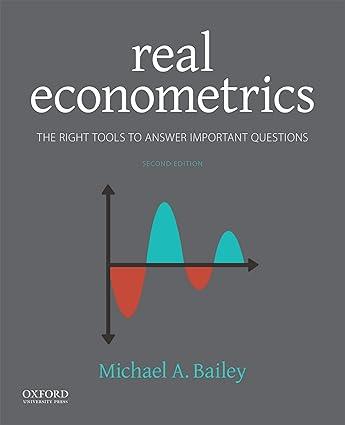This problem uses a panel version of the data set to analyze the effect of cell phone
Question:
This problem uses a panel version of the data set to analyze the effect of cell phone and texting bans on traffic fatalities. Use deaths per mile as the dependent variable because this variable accounts for the pattern we saw earlier that miles driven is a strong predictor of the number of fatalities. Table 8.13 describes the variables in the data set Cellphone_panel_homework.dta; it covers all states plus Washington, DC, from 2006 to 2012.
(a) Estimate a pooled OLS model with deaths per mile as the dependent variable and cell phone ban and text ban as the two independent variables. Briefly interpret the results.
(b) Describe a possible state-level fixed effect that could cause endogeneity and bias in the model from part (a).
(c) Estimate a one-way fixed effects model that controls for statelevel fixed effects. Include deaths per mile as the dependent variable and cell phone ban and text ban as the two independent variables. Does the coefficient on cell phone ban change in the manner you would expect based on your answer from part (a)?
(d) Describe a possible year fixed effect that could cause endogeneity and bias in the fixed effects model in part (c).
(e) Use the hybrid de-meaned approach discussed in the chapter to estimate a two-way fixed effects model. Include deaths per mile as the dependent variable and cell phone ban and text ban as the two independent variables. Does the coefficient on cell phone ban change in the manner you would expect based on your answer in part (d)?
(f) The model in part (e) is somewhat sparse with regard to control variables. Estimate a two-way fixed effects model that includes control variables for cell phones per 10,000 people and percent urban. Briefly describe changes in inference about the effect of cell phone and text bans.
(g) Estimate the same two-way fixed effects model by using the least LSDV approach. Compare the coefficient and \(t\) statistic on the cell phone variable to the results from part (f).
(h) Based on the LSDV results, identify states with large positive and negative fixed effects. Explain what these mean (being sure to note the reference category), and speculate about how the positive and negative fixed effect states differ. (It is helpful to connect the state number to state name; in Stata, do this with the command list state state numeric if year \(==2012\).)
Step by Step Answer:

Real Econometrics The Right Tools To Answer Important Questions
ISBN: 9780190857462
2nd Edition
Authors: Michael Bailey





